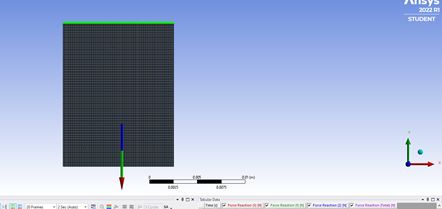-
-
December 9, 2022 at 10:56 pm
Costas
SubscriberHello Everyone,
I’m carrying out Static Structural analysis simulating a compression test with ANSYS student 2022R1.
I use isotropic elasticity together with multilinear isotropic hardening. The analysis is assumed to be axisymmetric since my specimen is cylindrical. The upper edge is given a displacement B.C. of Y=-0.005 mm (and free in X), the bottom face is given a displacement B.C. Y=0, X=free, and the left vertice of the bottom edge (the one on the Y axis) is fixed.
I probe a Reaction Force at the top edge and the result is as shown in the picture.
I cannot understand why the force arrow starts at a point in the body. I would expect it to start on the top edge.
Besides, ANSYS documentation says: “An axisymmetric analysis is based on 360°. Calculation and all appropriate output data are on a full 360° basis”. So, if I take the reaction force scoped to the top edge of the axisymmetric model and divide it by the circular area of my specimen’s top face, I will get the relevant normal stress; is that correct?
Thank you,
Costas
-
December 10, 2022 at 12:59 am
peteroznewman
SubscriberYes, the Reaction Force divided by the circular area of the top is the normal stress.
Don't worry about the location of the Reaction Force arrow, it's just a display icon.
-
December 10, 2022 at 11:00 am
Costas
SubscriberHi Peter,
many thanks for your response. So, the arrow of the reaction force does not pass through the point/line of action of the actual force (I suppose if I want such relevant information I would need to find the respective moment). However, in a 2D plane strain analysis I did, the arrow of the reaction force displays as expected (passing through the point of action).
May I also confirm that the reaction force is equal to the appropriate summation of the user defined results: F, FVECTORS, ENFO?
Regards,
Costas
-
December 10, 2022 at 11:29 am
peteroznewman
SubscriberI don't know what those user defined results are. You could look up the definition of them in Ansys Help. What do you get when you sum them up and compare it to the reaction force?
-
December 10, 2022 at 12:17 pm
Costas
SubscriberThose are nodal (F, FVECTORS) and elemental nodal (ENFO) forces. When I sum them up I indeed get the reaction force. I just wanted to confirm that this is by definition true and not due to the simple model I use.
-
- The topic ‘Reaction Force in 2D axisymmetric analysis’ is closed to new replies.



-
3572
-
1188
-
1076
-
1063
-
952

© 2025 Copyright ANSYS, Inc. All rights reserved.








